Composting wood chips is a great way to reduce waste and create nutrient-rich soil for your garden. However, it can take a long time for wood chips to break down naturally. There are however lots of ways that you can help them to break down faster.
One of the keys to composting wood chips fast is to make sure that they are properly prepared before adding them to your compost pile. Reducing the size of the chips, adding nitrogen-rich materials, and inoculating the pile with beneficial microbes can all help to break down the wood chips faster.
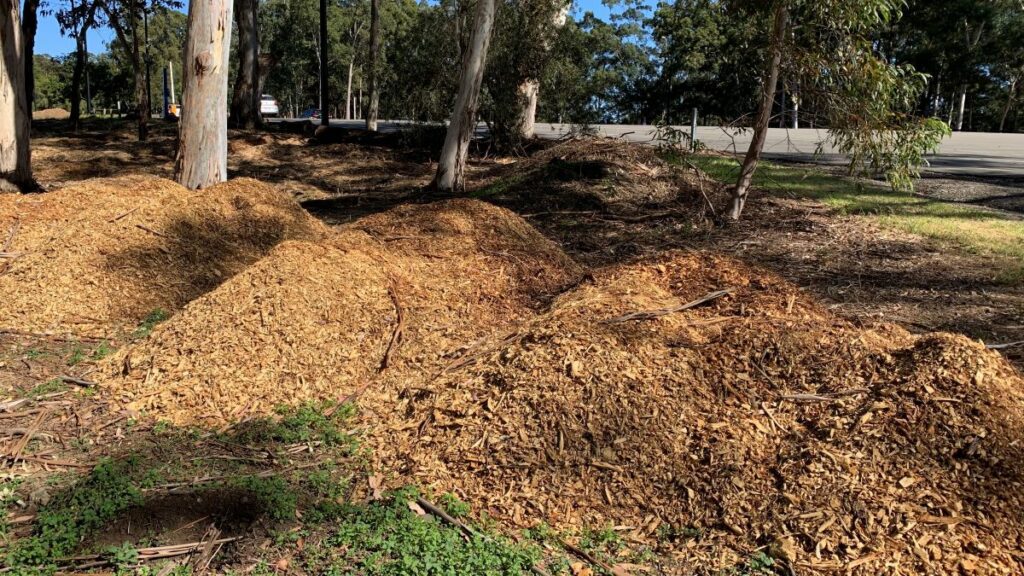
Starting your compost pile in early spring is a great way to break down wood chips fast. When the weather is warming up and when there is spring rain, microorganisms will grow faster and break down the wood chips faster.
This article will explore some of the best ways to help you to break down wood chips into compost faster.
Key Takeaways
- Proper preparation of wood chips is essential for fast composting.
- Adding nitrogen-rich materials and inoculating the compost pile can help to speed up the process.
- Monitoring the composting process and making adjustments is essential to help them break down fast.
Wood Chips Composting – The Basics
Composting wood chips is a great way to turn waste into a valuable resource that can help improve soil quality and promote plant growth. However, the process can take a long time if not done correctly. Here are some key things to keep in mind when composting wood chips:
Types of Wood Chips
The type of wood the wood chips come from will determine how fast they break down. Some types of wood chips, such as those from hardwood trees decompose more slowly than those from softer woods such as pine.
Some wood chips may contain chemicals or other contaminants that can be harmful to plants or soil like those that are colored with inorganic dyes.
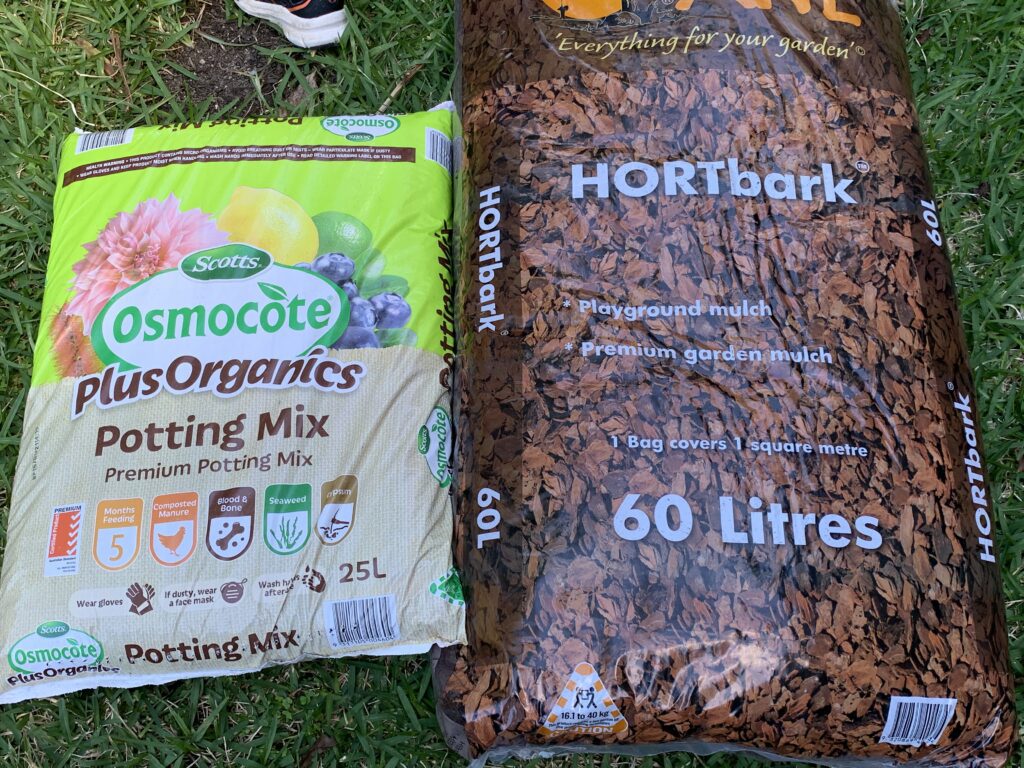
When composting wood chips, it’s important to use clean, untreated chips from a reliable source.
Carbon to Nitrogen Ratio
The carbon to nitrogen ratio (C) is an important factor in composting wood chips. Wood chips are high in carbon, which is important for maintaining a healthy compost pile. However, too much carbon can slow down the composting process. Carbon based materials are also known as ‘brown materials’ like hay, straw, dry fall leaves.
To break down wood chips faster, it’s important to add materials that are high in nitrogen, such as grass clippings, vegetable scraps, organic food waste, or manure to balance out the carbon content of the wood chips. Aim for a ratio of carbon based or ‘brown’ to green nitrogen ingredients of 3:1 for best results.
Size and Moisture
The size of your wood chips can also affect how quickly they decompose. Smaller chips will break down faster than larger ones. You can use a wood chipper or mulcher to break down the wood chips into smaller pieces.
It’s also important to keep your compost pile moist to help it to break down faster. Aim for a moisture level of around 50-60% for best results. You can use a moisture meter to check the moisture level of your compost pile.
Fresh wood chips will take longer to break down than older wood chips. Older wood chips will be dryer and will have already started to break down. Letting wood chips dry out for a number of weeks before attempting to compost them will help them to break down faster.
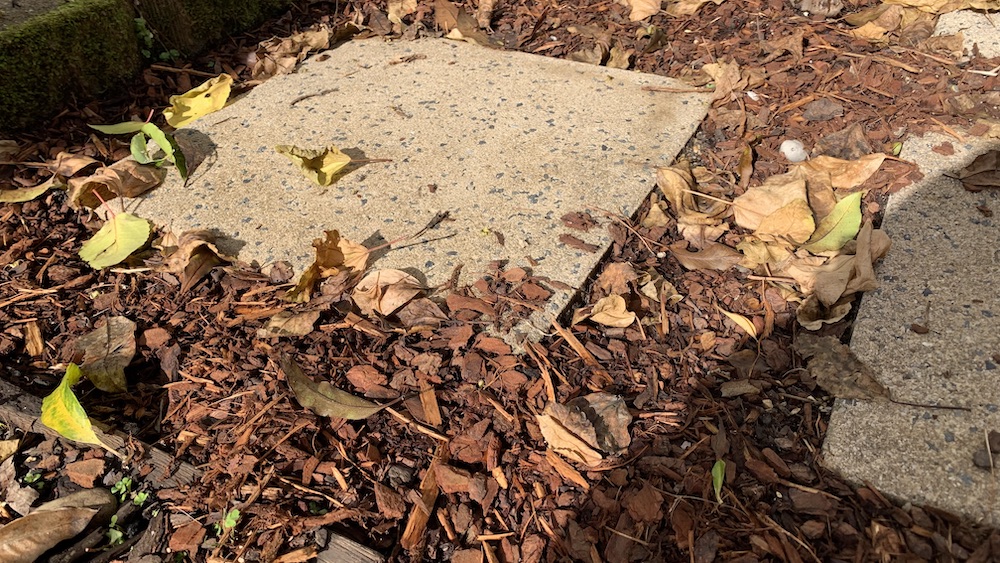
Turning and Mixing
Turning and mixing your compost pile is another important factor in composting wood chips. This helps to aerate the pile and distribute moisture and nutrients evenly. Aim to turn your compost pile every 1-2 weeks, or as needed to maintain a healthy balance of carbon and nitrogen.
Preparation of Wood Chips for Composting
Before starting the composting process, it is important to prepare the wood chips properly to make sure they break down quickly and effectively. This section will cover the two main steps in preparing wood chips for composting: sorting and cleaning, and cutting and shredding.
Sorting and Cleaning
The first step in preparing wood chips for composting is to sort and clean them. This involves removing any debris, such as rocks or twigs, and separating out any large pieces of wood that will take longer to break down.
It is also important to remove any treated or painted wood, as these can contain chemicals that are harmful to the compost and the plants it will be used on.
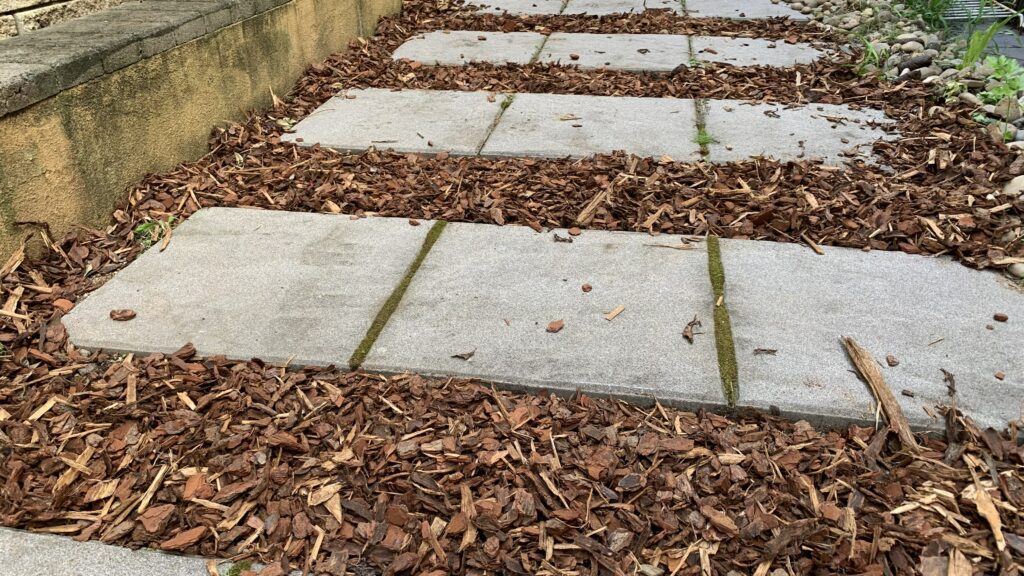
Cutting and Shredding
The second step in preparing wood chips for composting is to cut and shred them into smaller pieces. This increases the surface area of the wood chips, allowing them to break down faster. There are several ways to cut and shred wood chips, including using a wood chipper or shredder.
The smaller the wood chips pieces are, the faster they will break down. By properly preparing your wood chips for composting, you can ensure that they break down quickly and effectively, providing valuable nutrients for your plants.
Composting Process
Composting wood chips is a simple and effective way to create nutrient-rich soil for your garden. To get the most out of your wood chip compost, it’s important to follow a few key steps in the composting process.
Layering
Layering is an important step in the composting process. Start by creating a base layer of green organic materials such as grass clippings, green leaves, vegetable scraps, or manure.
Green materials are high in nitrogen and water and will help the bark chips to break down faster. Then, add a layer of wood chips on top of the green material. Repeat this process until your compost heap is at least three feet tall.
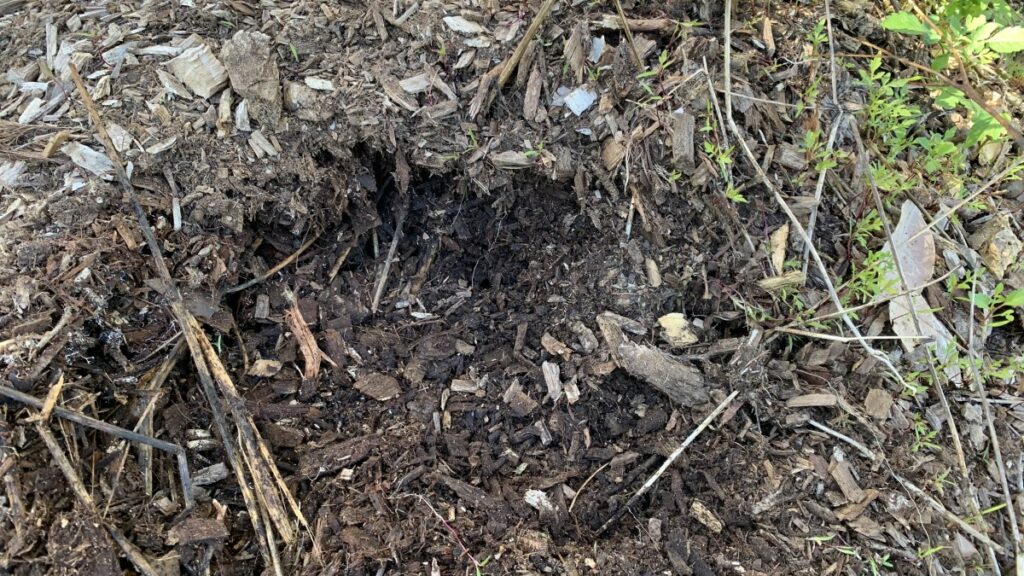
Turning and Aeration
Turning and aerating your compost pile is crucial to keep the process going. Use a pitchfork or shovel to turn the pile at the start to mix all of the ingredients through and then every few weeks. This will help to introduce oxygen into the pile of wood chips and ingredients, which is essential for the composting process.
If you have a large compost pile you might need to split it in half to make sure you can dig it over well. You can then put it back up into a larger pile to break down.
Moisture and Heat Management
Moisture and heat are two important factors in the composting process. Your compost pile should be moist but not overly wet. If the pile is too dry, add water. If it’s too wet, add more dry material such as leaves or straw.
To speed up the composting process, it’s important to maintain a temperature of 135-160°F. You can use a compost thermometer to monitor the temperature. If the pile is too cool, add more green material. If it’s too hot, turn the pile more frequently to introduce more oxygen.
By following these steps, you can create high-quality compost from your wood chips in as little as a few months. The smaller the bark pieces are, the faster they will turn into compost ready for your garden. When the compost looks like soil and there are no large pieces left, it is ready.
Accelerating Composting
If you want to compost wood chips fast, there are a few things you can do to accelerate the process. In this section, we will discuss two ways to speed up composting: the use of composting accelerators and proper carbon to nitrogen ratio.
Use of Composting Accelerators
Composting accelerators are products that contain beneficial microbes that help break down organic matter faster. They can be added directly to your compost pile and mixed through. Some common types of composting accelerators include:
- Compost tea: This is a liquid fertilizer made by steeping compost in water. It contains beneficial microorganisms that can speed up the composting process. Simply pour the liquid into your compost pile and mix it through with a garden fork.
- Manure: Adding manure to your compost pile can introduce beneficial bacteria that will help break down the organic matter. Broken down chicken manure or cow manure will both work well to speed up the breakdown process.
- Worm castings: Worm castings are rich in beneficial microorganisms and can help speed up the composting process. Add a small handful every week to introduce more soil bacteria. You do not need to add woms, just let the microbes do the work.
- Blood meal: Adding blood meal to your compost pile will help it to break down faster. This will add extra nitrogen to the pile, encouraging microorganism growth and speed up the breakdown process.
- Old compost: If you have an established compost pile adding a shovel full of old compost to your new pile will help it to break down faster. It will add extra microorganisms and help it to break down fast.

Proper Carbon to Nitrogen Ratio
The proper carbon to nitrogen ratio is essential for fast composting. Wood chips have a high carbon content, so it’s important to add nitrogen-rich materials to balance the ratio. I like to add around 3 parts carbon based materials like wood chips, hay or fall leaves to 1 part green or nitrogen based material. Some examples of nitrogen-rich materials include:
- Grass clippings: Grass clippings are high in nitrogen and can be added to your compost pile to balance the carbon to nitrogen ratio.
- Kitchen scraps: Vegetable and fruit scraps are also high in nitrogen and can be added to your compost pile.
- Coffee grounds: Coffee grounds are an excellent source of nitrogen and can be added to your compost pile.
In addition to adding nitrogen-rich materials, it’s also important to keep your compost pile moist and aerated. Turning your compost pile regularly will help introduce oxygen and speed up the composting process.
Monitoring the Composting Process
Once you have set up your compost pile with wood chips, it’s important to monitor the process to ensure that it’s working effectively. Here are some tips on how to monitor the composting process:
- Temperature: Check the temperature of the compost pile regularly using a compost thermometer. The ideal temperature range is between 120°F and 160°F at the center of the pile. If the temperature is too low, the composting process will be slow, and if it’s too high, it can kill off beneficial microorganisms.
- Moisture: Keep the compost pile moist but not too wet. The ideal moisture level is around 50-60%. You can test the moisture level by squeezing a handful of compost. If it feels like a wrung-out sponge, it’s at the right moisture level.
- Aeration: Regularly turn the compost pile to ensure that it’s getting enough oxygen. This will help to speed up the composting process and prevent unpleasant odors from developing.
- Odor: If you notice any unpleasant odors coming from the compost pile, it may be too wet or not getting enough oxygen. Turning the pile and adding dry materials like leaves or straw can help to alleviate this issue.
- Pests: Keep an eye out for any pests like rodents or flies that may be attracted to the compost pile. If you notice any pests, cover the pile with a tarp or add a layer of dry materials to discourage them.
By monitoring the composting process regularly, you can ensure that your wood chip pile is composting effectively and producing nutrient-rich compost for your garden.
Finalizing and Using Composted Wood Chips
Once your wood chips have fully composted, you can use them in a variety of ways to improve your garden’s soil quality. Here are some tips on how to use your finished compost:
- Mix with soil: Once the wood chips have fully broken down, the compost can be mixed with your soil to improve its quality. Mix the composted wood chips with the soil in a 1:1 ratio to create a nutrient-rich soil mixture for your plants. They are great for your vegetable garden, for top dressing citrus trees or any other garden bed with established plants.
- Mulch: Composted wood chips can be used as mulch to conserve moisture and reduce weed growth in your garden. Spread a layer of composted wood chips on top of the soil around your plants, making sure to leave a small gap around the stem to prevent rot.
- Top-dressing: Composted wood chips can also be used as a top-dressing for your lawn. Spread a thin layer of composted wood chips on top of your grass to improve its health and appearance.
- Compost tea: Composted wood chips can be used to create compost tea, which is a nutrient-rich liquid fertilizer. To make compost tea, place a handful of composted wood chips in a mesh bag and steep it in a bucket of water for a few days. Use the resulting liquid to water your plants.
Remember that composted wood chips should be used in moderation, as too much can create an imbalance in your garden’s soil. Start with small amounts and gradually increase as needed. With these tips, you can make the most of your composted wood chips and improve the health of your garden.
Frequently Asked Questions
What are some nitrogen sources that can be added to wood chips for faster composting?
Nitrogen sources that can be added to wood chips for faster composting include grass clippings, manure, vegetable scraps, and coffee grounds. These sources help to balance the carbon-to-nitrogen ratio in the compost pile, which speeds up the decomposition process.
How long does it typically take for wood chips to compost?
Wood chips can take anywhere from several months to a year to compost, depending on the size of the chips, the moisture content, and the temperature of the compost pile. However, by following certain techniques like reducing chip size, and adding a good nitrogen source, you can speed up the process to as little as three to six months.
What are some ways to speed up the composting process for wood chips?
Some ways to speed up the composting process for wood chips include using smaller chip sizes, adding nitrogen sources, keeping the compost pile moist, turning the pile regularly, and ensuring proper aeration. Hot composting, which involves maintaining a temperature of 140-160°F, can also speed up the process.
Can wood chips be turned into mulch and used in the garden?
Yes, wood chips can be turned into mulch and used in the garden. Wood chip mulch offers many benefits, such as retaining moisture, suppressing weed growth, and adding nutrients to the soil as it breaks down over time.
Where can I find composted wood chips for purchase?
Composted wood chips can be found at many garden centers, home improvement stores, and landscaping companies. You can also check with your local municipality to see if they offer free or low-cost composted wood chips.
I am an accredited practicing dietitian, experienced gardener and a dedicated cook. I love writing and sharing my experience so you can learn from my successes and mistakes.
